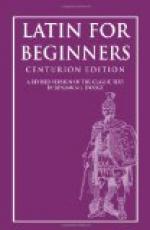[Footnote 2: Not longius\. Why?]
[Footnote 3: Latin, was distant by a small space.]
[Footnote 4: Not the accusative.]
LESSON LIX
NUMERALS (Continued) : THE ACCUSATIVE OF EXTENT
[Special Vocabulary]
agmen, agminis\, n., _line of march,
column_;
pri:mum agmen\, the
van;
novissimum agmen\, _the
rear_
atque\, ac\, conj., _and_; atque\
is used before vowels and
consonants, ac\ before
consonants only. Cf. et\ and /-que\
concilium, conci’li:\, n., _council,
assembly_
Helve:tii:, -o:rum\, m., the Helvetii,
a Gallic tribe
passus, passu:s\, m., _a pace_, five
Roman feet;
mi:lle passuum\, a
thousand (of) paces, a Roman mile
qua: de: causa:\, _for this
reason, for what reason_
va:llum, -i:\, n., earth-works,
rampart
cado:, cadere, cecidi:, ca:su:rus\,
_fall_ (decadence)
de:do:, de:dere, de:didi:, de:ditus\,
surrender, give up;
with a reflexive pronoun,
surrender one’s self, submit, with the
dative of the indirect object
premo:, premere, pressi:, pressus\,
_press hard, harass_
vexo:, vexa:re, vexa:vi:, vexa:tus\,
annoy, ravage (vex)
333. Learn the first twenty of the ordinal numerals (Sec. 478). The ordinals are all declined like bonus\.
334. The distributive numerals are declined like the plural of bonus\. The first three are
singuli:, -ae, -a, one
each, one by one
bi:ni:, -ae, -a, two each,
two by two
terni:, -ae, -a, three
each, three by three
335. We have learned that, besides its use as object, the accusative is used to express space relations not covered by the ablative. We have had such expressions as per plurimos annos\, _for a great many years_; per totum diem\, for a whole day. Here the space relation is one of extent of time. We could also say per decem pedes\, _for ten feet_, where the space relation is one of _extent of space_. While this is correct Latin, the usual form is to use the accusative with no preposition, as,
Vir totum diem cucurrit, the man ran
for a whole day
Caesar murum decem pedes movit, Caesar
moved the wall ten feet
336. RULE. Accusative of Extent. Duration of time and extent of space are expressed by the accusative.
a. This accusative answers the questions how long? how far?
b. Distinguish carefully
between the accusative of time how long
and the ablative of time when,
or within which.
Select the accusatives of time and space and the ablatives of time in the following:




